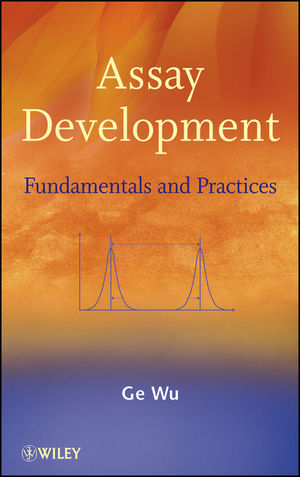Assay Development: Fundamentals and PracticesISBN: 978-0-470-19115-6
Hardcover
452 pages
April 2010
 This is a Print-on-Demand title. It will be printed specifically to fill your order. Please allow an additional 10-15 days delivery time. The book is not returnable.
|
||||||
Chapter 1 Introduction to assay development.
1.1 Assay and Bioassay.
1.2 Drug discovery process and the role of assays in the process.
1.3 Bioassay development.
1.4 Bioassay Classifications.
Chapter 2 Measurement and Instrumentation.
2.1 Measurement and perturbation..
2.2 Common instrumental methods and instrument components.
2.3 Molecular absorption measurements.
2.4 Molecular luminescence measurements.
2.5 Luminescence lifetime measurement and time-resolved fluorescence (TRF) measurement..
2.6 Fluorescence resonance energy transfer (FRET) and TR-FRET.
2.7 Fluorescence quenching.
2.8 Fluorescence polarization.
2.9 Radioactivity measurement.
2.10 Evaluating and selecting an instrumental method for bioassay.
Chapter 3 Fundamental principles of assay with isolated proteins.
3.1 Chemical potential, equilibrium, and kinetics.
3.2 Protein binding studies at equilibrium.
3.3 Kinetic studies of protein binding process.
3.4 Enzyme kinetics.
3.5 Inhibition of protein function.
3.6 Assay development with isolated proteins.
Chapter 4 Separation-based techniques in bioassays.
4.1 Washing to remove impurity on solid support.
4.2 Organic extraction of hydrophobic molecules.
4.3 Centrifugation to remove dense particles.
4.4 Membrane filtration.
4.5 Liquid chromatography.
4.6 Electrophoresis.
Chapter 5 General protein binding assay formats.
5.1 Equilibrium dialysis.
5.2 Competitive binding assays with radioactive or other labeled ligands.
5.3 Application of SPATM and FlashplateTM in binding studies.
5.4 Application of FP assays in binding studies.
5.5 Application of FRET assays in binding studies.
5.6 Application of ELISA in binding studies.
5.7 Surface plasmon resonance (SPR) technology and its application in binding studies.
5.8 Application of label-free technologies in binding studies.
Chapter 6 Functional assays with isolated proteases.
6.1 Introduction to proteases and their substrates.
6.2 The function of proteases and their role drug discovery.
6.3 Protease assays.
6.4 Protease substrate profiling.
6.5 Protease inhibitors.
6.6 Assay development for caspases with fluorogenic substrate..
6.7 Assay development for Carboxypeptidase U..
Chapter 7 Functional assays with isolated kinases.
7.1 Introduction to protein kinases.
7.2 Substrates for in vitro kinase assays.
7.3 Kinase assay development strategies.
7.4 Kinase assay based on the detection of the phosphorylated product.
7.5 Kinase Assays by measuring the generation of ADP.
7.6 Kinase assays by measuring the depletion of ATP.
7.7 Kinase assays by measuring the depletion of peptide substrate.
7.8 Kinase assays by measurement of both product and substrate simultaneously.
7.9 An example of a kinase assay development in HTRF format..
Chapter 8 Fundamental principles of cell-based assays.
8.1 Cell signaling, signal transduction, and cellular responses.
8.2 General approaches in cell-based assays.
8.3 The concept of affinity and efficacy in cell-based assays.
8.4 Development of cell-based assays.
Chapter 9 Assays with ion channels.
9.1 Introduction to ion channels.
9.2 Strategies for ion channel assays.
9.3 Electrophysiological methods.
9.4 Ion flux methods.
9.5 Membrane potential sensing methods.
9.6 Selecting suitable assays for ion channel studies.
Chapter 10 Assays with G protein-coupled receptors.
10.1 Introduction to GPCRs and G proteins.
10.2. GPCR activation and signal transduction.
10.3 Strategies of GPCR assay development.
10.4 GPCR assays by measuring the extent of GTP binding to G?.
10.5 GPCR assays based on measurement of cAMP.
10.6 GPCR assays based on the measurement of intracellular inositol phospholipids.
10.7 GPCR assays based on the measurement of intracellular Ca2+.
10.8. GPCR assays based on the measurement of MAPK activity.
10.9. GPCR assays with reporter gene.
10.10 GPCR assays by monitoring events leading to GPCR internalization.
Chapter 11 Assays based on the integrated system properties of cells.
11.1. Cell viability, proliferation, and cytotoxicity assays.
11.2. Measurement of extracellular indicators of cellular metabolism.
11.3. Measurement of cell?s effect on electrical impedance.
11.4. Measurement of protein secretion from cells.
11.5. Measurement of discoloration of melanophore cells.
11.6. Measurement of cell motility.
Chapter 12 High content cell-based assay with optical imaging techniques.
12.1 Sample preparation.
12.2 Cellular image collection.
12.3 Image abstraction, analysis, and data management.
12.4 Applications of image-based cellular high content screening.
Chapter 13 High throughput screening.
13.1 Introduction to high throughput screening.
13.2 Molecular or cellular target and assay development.
13.3 Compound library management.
13.4 Hardware module.
13.5 Software module.
13.6 HTS operation management.
13.7 Building an HTS operation for biopharmaceutical discovery.
13.8 Quality control and data analysis in primary screening.
Chapter 14 A case study: The development of a microfluidic-based kinase assay platform.
14.1 Background of microfluidic technology and its application in bioassays.
14.2 The original Caliper?s mobility shift kinase assay format.
14.3 Realizing the flaws in Caliper?s original kinase assay format.
14.4 Searching for alternative kinase assay methods.
14.5 The development of the off-chip kinase assay format.
14.6 Current stage of microfluidic technology in bioassays.
14.7 Appendix: A poster presented in 2002 Society for Biomolecular Screening annual meeting.



